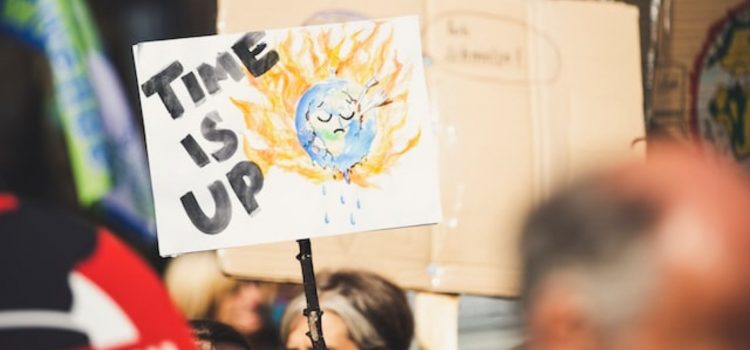

This article is an excerpt from the Shortform book guide to "Apocalypse Never" by Michael Shellenberger. Shortform has the world's best summaries and analyses of books you should be reading.
Like this article? Sign up for a free trial here.
Is there a climate crisis? Is climate alarmism called for? Who and what is to be believed?
Even though it’s becoming more widely accepted that climate change is real, questions remain. We’re struggling to find answers, much less consensus, on what steps we should take, whether they’ll be enough, and how drastic the environmental situation really is.
Keep reading for an assessment of the climate situation from award-winning science writer Michael Shellenberger.
Is There a Climate Crisis?
Is there a climate crisis? To begin, Shellenberger makes it clear that climate change is real and is primarily driven by the human race. But, he’s dismayed at climate alarmism, contending that environmental doomsayers spread misinformation just as much as climate change deniers. When climate activists fudge the truth for the sake of spurring people into action, they do their cause more harm than good. To demonstrate his point, Shellenberger discusses the warnings of environmental experts, the way that journalists selectively filter climate reports for the most alarming headlines, and the counterproductive psychological effects of presenting worst-case scenarios as unavoidable.
The leading source of information on the climate change problem is the UN’s Intergovernmental Panel on Climate Change (IPCC). The IPCC produced a series of reports in 2018 and 2019 that predict irreversible harm to the ecosphere if current climate trends continue. IPCC scientists and others have warned that extreme weather events will endanger food and water supplies for billions of people, greenhouse gas emissions are out of control, and the cost of damage from disasters such as hurricanes and forest fires will continue to skyrocket. In its 2019 report, the IPCC stated that carbon emissions worldwide need to drop 45% by the year 2030 in order to limit global warming to 1.5 degrees Celsius and prevent irreversible harm to the ecosphere.
(Shortform note: Though he agrees with Shellenberger that the threat of climate change isn’t unmanageable, Bjorn Lomborg, in his book False Alarm, points out that reducing carbon emissions won’t be enough to halt global warming. The best it can do is slow the rate at which global temperatures increase. However, based on the same prediction models used by the IPCC, Lomborg calculates that if nothing is done to curb emissions, global temperatures could increase by over four degrees Celsius by the end of the century.)
However, the IPCC doesn’t predict the end of the world if their climate goals aren’t met. Shellenberger explains that scientists create weighted probabilities for a variety of scenarios, from best-case to worst-case, with multiple caveats and qualifications for each. To get the most attention-grabbing headlines, journalists fixate on the most dire predictions and present them as foregone scientific conclusions, no matter that such claims are grossly overstated and miss any nuance that might moderate their hyperbole.
(Shortform note: Climate scientists’ models for predicting rates of global warming have become more sophisticated over time, yet even projections made 30 years ago have proven to be remarkably accurate. However, even if climate numbers are trending away from “worst-case scenarios,” global warming is still on the rise and will be strongly influenced by what actions we take. Scientists worldwide report that the effects of climate change are hitting communities faster than expected, casting doubt on whether people in the most vulnerable regions will be able to adapt in time.)
Impending Disaster
One argument often cited as evidence for the runaway impact of climate change is that natural disasters are becoming more common, deadly, and destructive. This, says Shellenberger, is a prime example of environmentalist distortion. He argues that natural disasters are becoming more costly, but not because the climate is making them worse. Instead, the rise in damage tolls from events like hurricanes and wildfires is due to more people choosing to live in harm’s way by building subdivisions in dry, fire-prone areas and expanding communities in low, coastal regions.
(Shortform note: In addition to incurring risk from hurricane damage, a great deal of modern coastal development has been labeled unsustainable for its impact on wildlife and its acceleration of coastal erosion. However, rebuilding continues in damaged areas, usually at taxpayer expense. In The Last Resort, Sarah Stodola targets beach tourism as a particularly egregious example of coastal development’s impact on ecosystems, but even so, coastal habitation is unavoidable. Historically, coastal cities have always been crucial as ports for shipping and fishing, with eight of the world’s 10 largest cities located in coastal regions.)
One thing to consider is that the amount and value of coastal construction have dramatically increased in the last 100 years. When increases in coastal development are factored into calculations of hurricane damage as a form of property “inflation,” Shellenberger says the rising monetary impact of storms is completely explained by the rising value of development. Likewise, according to the United States Geological Survey, the increase in forest fires is linked to the rising number of power lines as an ignition source—a direct result of building more subdivisions in fire-prone areas. Humans are to blame for these impacts, but not in the way that alarmists suggest.
(Shortform note: Not only are humans the direct cause of most wildfires, but fires caused by humans are much more destructive than those ignited by natural causes, such as lightning. In addition to power lines, other human sources of ignition include campfires, firearms, fireworks, and burning trash. Human-related fires are more likely to begin closer to inhabited areas, and disproportionately occur on dry, windy days in which the risk of fire spreading is high. As a result, fires caused by humans spread faster and burn hotter than those that occur naturally, regardless of the effects of climate change. However, climate change may contribute to the conditions that exacerbate fires while making it harder for forests to recover.)
Yet, environmental activists cling to certain narratives, such as climate change making forest fires worse, with an almost religious fervor. Shellenberger goes so far as to label environmentalism as a “secular religion,” one driven by emotion more than reason. In its benign form, environmentalism motivates people to cherish nature and take steps to preserve it. However, in recent years, he says environmentalism has taken on aspects of a doomsday cult, with some groups predicting the end of the human race and even embracing it as a good outcome.
While this may provide some psychological boost to those acting as heralds for the End of Days, to the broader populace such alarmist screeds give rise to anxiety, depression, and worst of all, helplessness—the last thing we need to fight climate change. Shellenberger says that young people are particularly affected by predictions of environmental catastrophe, and why not? Based on the information being presented to children, it’s perfectly reasonable for many to believe that the human race will die out in their lifetimes and that it’s the fault of evil and stupidity when, in truth, that’s far from the case. Shellenberger goes on in his book to make a case for climate optimism.
(Shortform note: While Shellenberger and others argue that concerns over climate change are developing into a widespread mental health crisis, increasing anxiety over climate-related issues may be a vital component of the solution. Predictive models of human-driven climate change rely on assumptions about human behavior. New studies show that rising climate anxiety and awareness can better help people make behavioral changes toward more eco-friendly lifestyles. In Psychology and Climate Change, Susan Clayton and Christie Manning show that climate change’s social and mental health effects can be leveraged to encourage people and communities to take proactive steps toward a sustainable future.)

———End of Preview———
Like what you just read? Read the rest of the world's best book summary and analysis of Michael Shellenberger's "Apocalypse Never" at Shortform.
Here's what you'll find in our full Apocalypse Never summary:
- An assessment of the climate crisis from a rational perspective
- How climate change alarmists are doing more harm than good
- The problems with renewable energy and why we should switch to nuclear






